How to Build a CRUD App with Backbone.js? A Step-by-Step Tutorial
In this guide, you'll learn how to create a functional CRUD (create, read, update, delete) application using Backbone.js.
This walkthrough will help you understand the core operations of a web application by showing you how to construct a CRUD system that effectively manipulates and manages data.
You will begin by setting up a Back4app project titled Basic-CRUD-App-Backbone to serve as a reliable backend for your application.
After that, you'll design a flexible database schema by defining specific collections and fields—either manually or with assistance from the Back4app AI Agent. This process ensures your data structure is tailored for seamless CRUD interactions.
Next, you will use the intuitive Back4app Admin App, which features a drag-and-drop interface, to easily handle your data collections. This tool simplifies CRUD operations, making backend data management straightforward.
Finally, you'll connect your Backbone.js frontend to Back4app using the REST API and guide relies on standard API calls to interact with your backend. You’ll also learn how to secure your data with robust access controls.
By the conclusion of this tutorial, you'll have constructed a production-ready web application that supports CRUD functionalities and includes user authentication along with advanced data management features.
- Master the art of building CRUD applications that handle data effectively using a dependable backend service.
- Discover strategies for creating a scalable database design and integrating it with a Backbone.js frontend.
- Learn to use the Back4app Admin App’s drag-and-drop features to simplify create, read, update, and delete tasks.
- Get acquainted with deployment methods, including Docker containerization, to quickly launch your application.
Before diving in, make sure you have:
- A Back4app account and an active project. Refer to Getting Started with Back4app if you need guidance.
- A Backbone.js development setup. You can include Backbone.js via a package manager like npm or by linking directly from a CDN.
- A basic understanding of JavaScript, Backbone.js, and RESTful APIs. Check out the Backbone.js documentation for a refresher if needed.
- Sign in to your Back4app account.
- Click on the “New App” button from your dashboard.
- Name your project: Basic-CRUD-App-Backbone and follow the prompts to set it up.
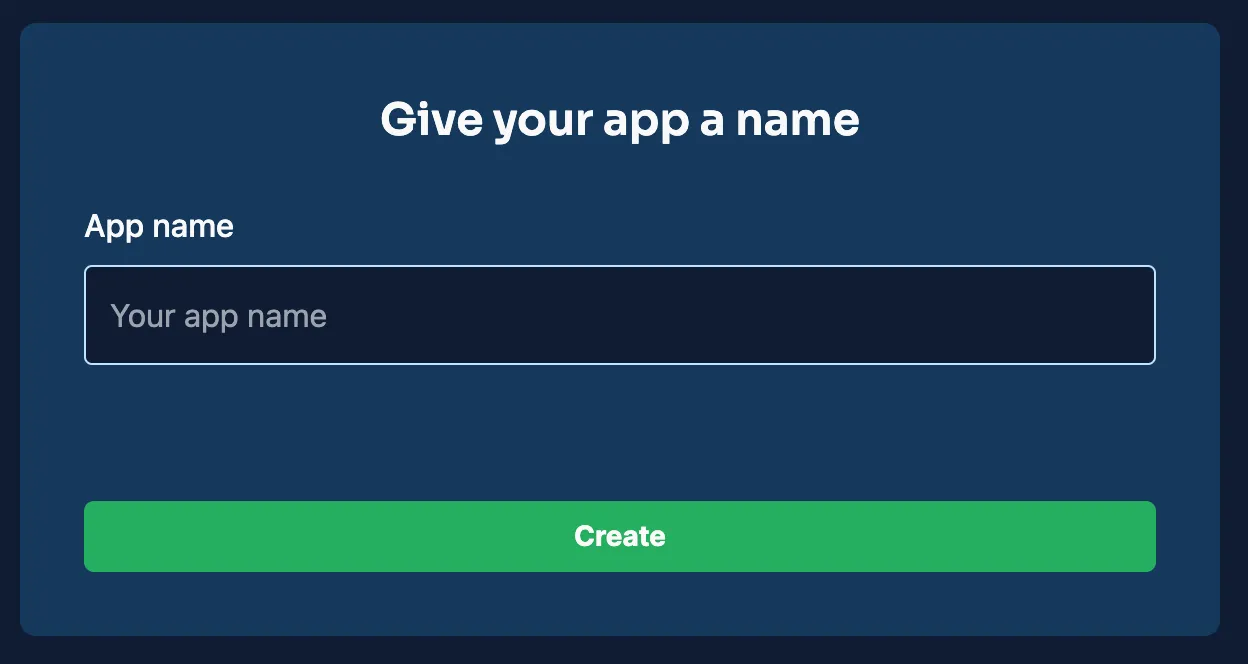
Once your project is created, it will be visible on your dashboard, ready to be configured as your backend for the application.
For this CRUD application, you will set up several collections. Below are sample collections with the fields and types you need to establish your schema, ensuring your app can perform all CRUD operations.
This collection will hold details for each item.
Field | Data Type | Description |
|---|---|---|
_id | ObjectId | Auto-generated unique identifier. |
title | String | Name or title of the item. |
description | String | A brief overview of the item. |
created_at | Date | Timestamp indicating when the item was added. |
updated_at | Date | Timestamp for the most recent update. |
This collection stores user details and authentication info.
Field | Data Type | Description |
|---|---|---|
_id | ObjectId | Auto-generated unique identifier. |
username | String | Unique identifier for the user. |
String | User’s unique email address. | |
password_hash | String | Securely hashed password. |
created_at | Date | Account creation timestamp. |
updated_at | Date | Last modification timestamp of the user data. |
You can create these collections manually via the Back4app dashboard by adding a new class for each collection and configuring the corresponding fields.
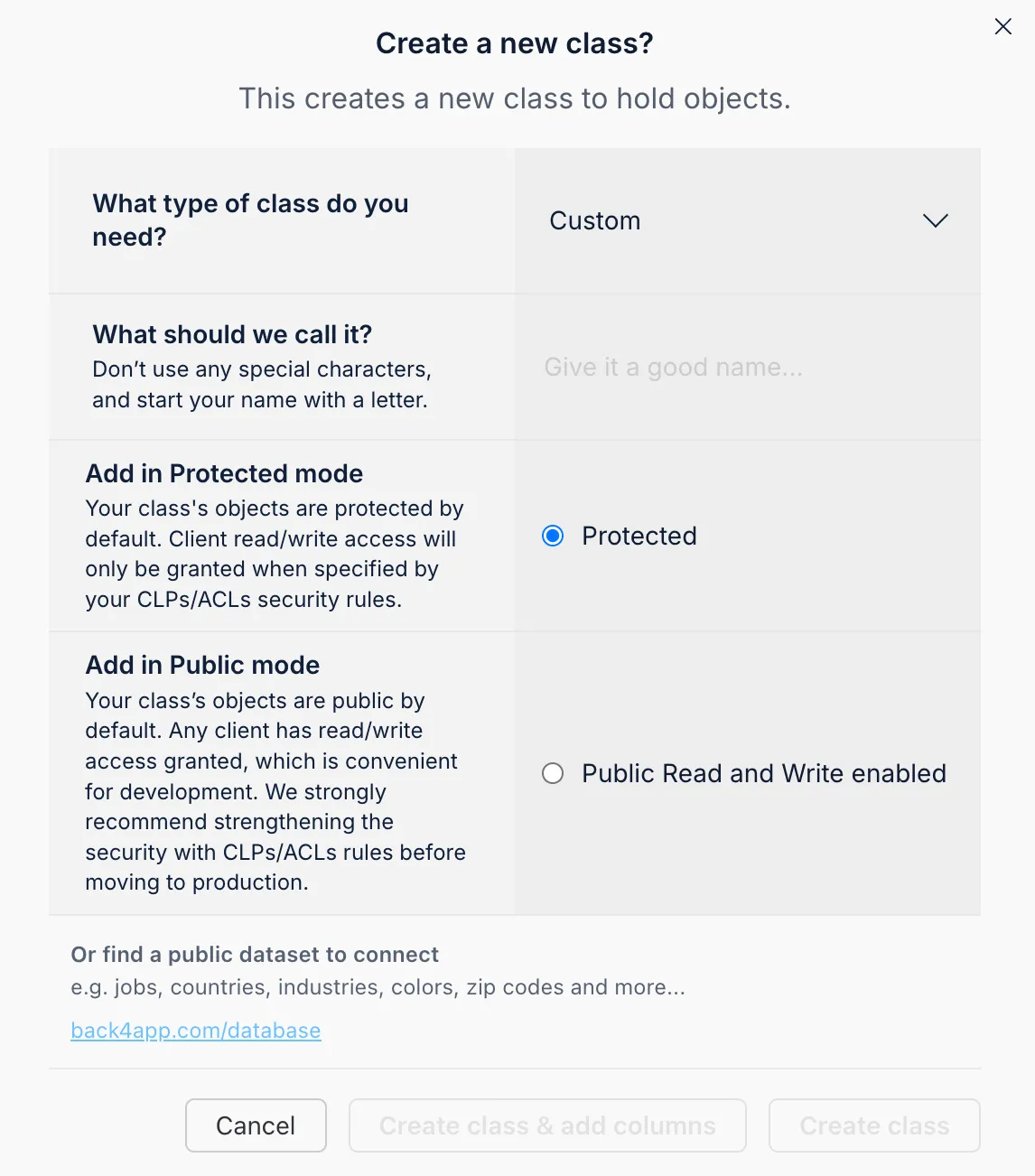
Simply choose a data type, set the field name, provide a default value if needed, and mark the field as required.
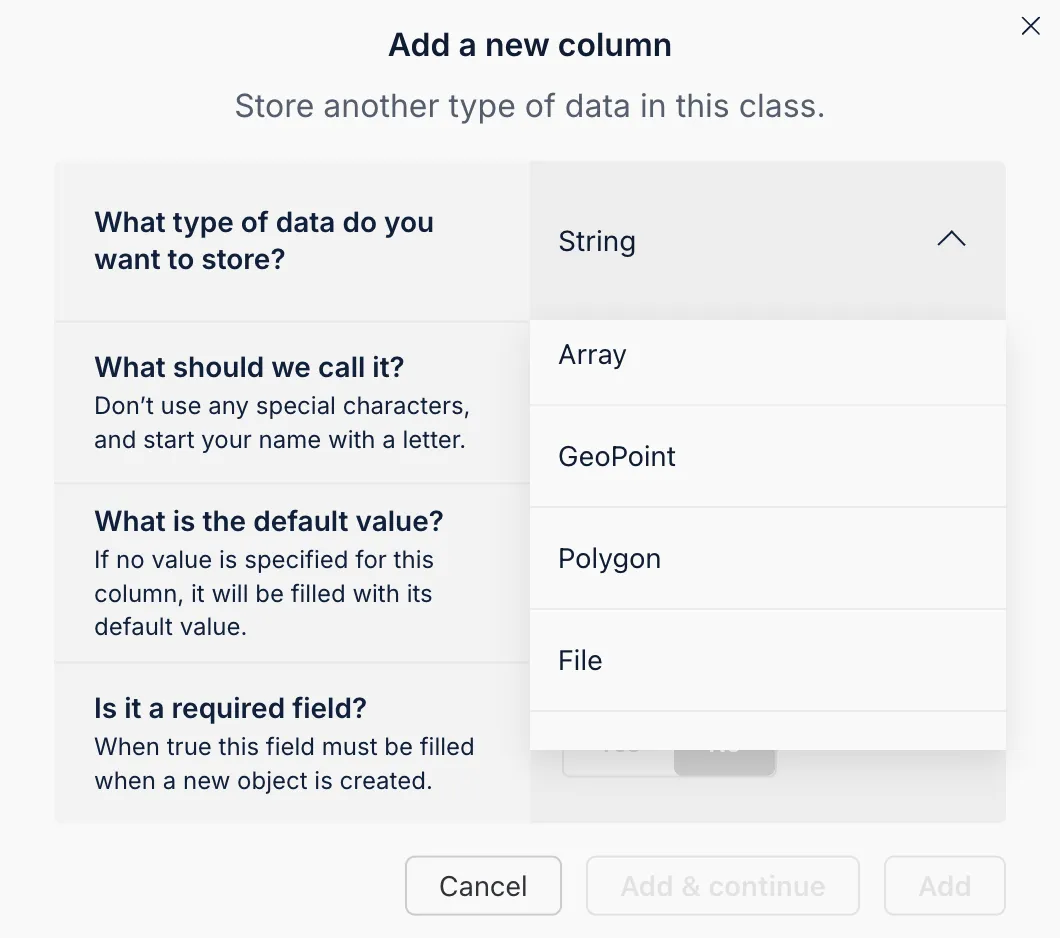
The Back4app AI Agent is a handy utility within your dashboard that helps automate database schema creation.
By inputting a descriptive prompt for your desired collections and fields, the AI Agent can swiftly generate the necessary database structure, saving you time and ensuring consistency.
- Access the AI Agent: Log into your Back4app dashboard and locate the AI Agent in the navigation or project settings.
- Detail Your Data Model: Input a prompt that outlines the collections and fields you require.
- Review and Implement: Evaluate the suggested schema and apply the changes to your project.
Utilizing the AI Agent ensures that your schema is properly structured for your application's requirements.
The Back4app Admin App is a no-code interface that lets you efficiently manage your backend data.
Its intuitive drag-and-drop design makes executing CRUD operations such as adding, viewing, modifying, and deleting records incredibly simple.
- Open the “More” menu from your Back4app dashboard.
- Select “Admin App” and then choose “Enable Admin App.”
- Set up your administrator credentials by creating the initial admin account. This step also establishes roles (like B4aAdminUser) and system collections.
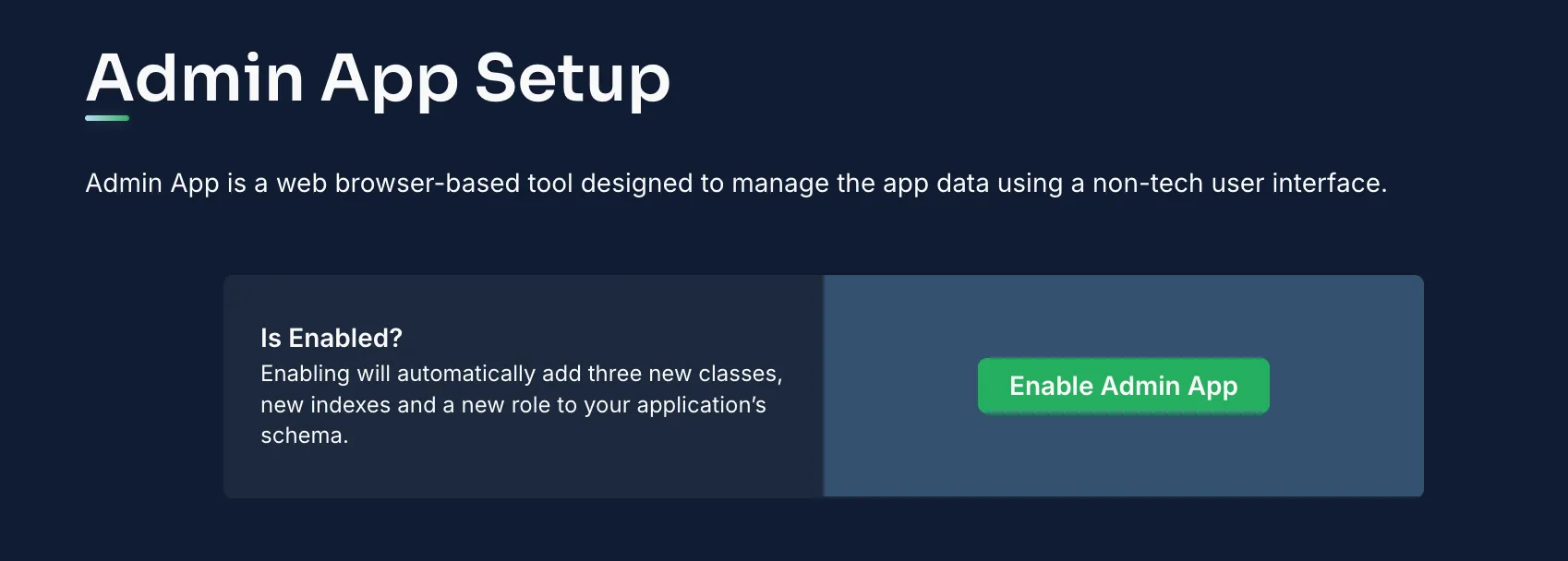
After activation, log in to the Admin App to handle your data seamlessly.
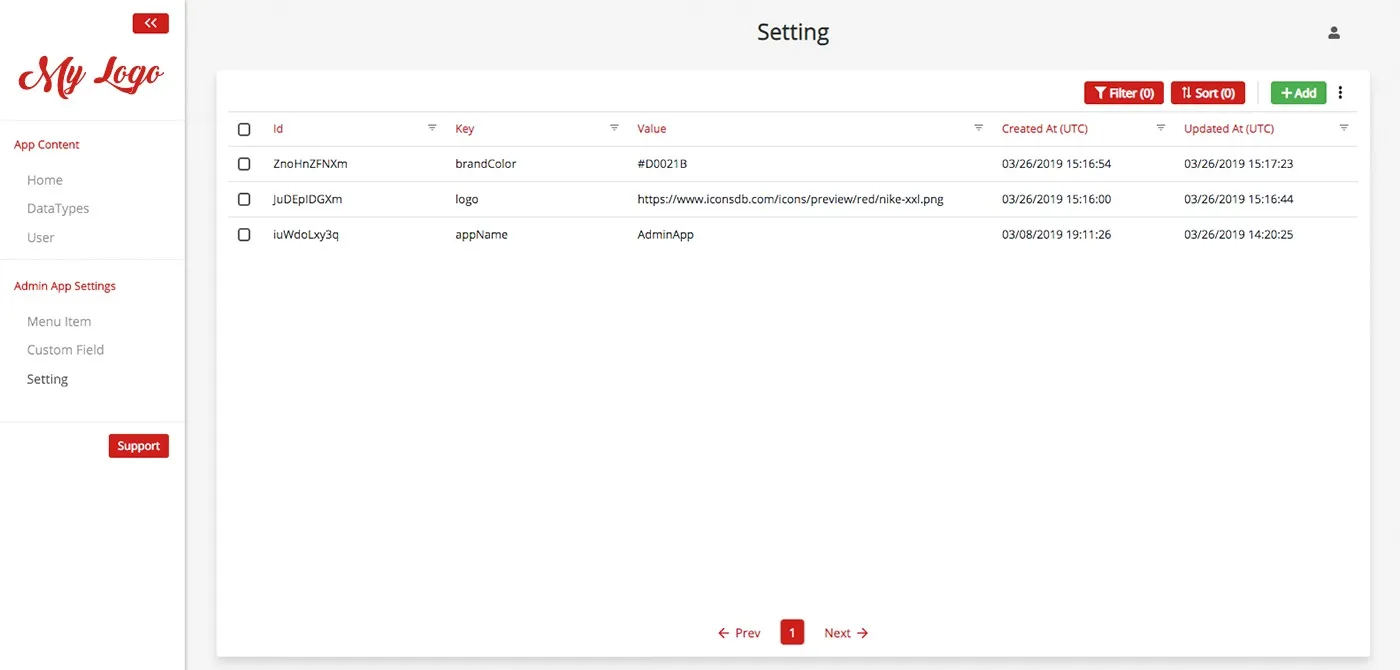
Within the Admin App you can:
- Add New Entries: Use the “Add Record” option in any collection (for instance, Items) to create new entries.
- View/Modify Records: Click on a record to inspect or alter its details.
- Remove Records: Utilize the delete feature to clear out unwanted data.
This interface enhances user experience by streamlining all data management tasks.
Now that your backend is configured, it's time to integrate your Backbone.js frontend with Back4app.
Since the Parse SDK is not tailored for Backbone.js, you'll employ Backbone’s built-in models, collections, and views in tandem with REST API calls to interact with Back4app.
Begin by defining a model for your items and a corresponding collection. For example:
Create a view to render the list of items and handle user actions such as adding, editing, and deleting.
This view fetches items from Back4app using the REST API and allows you to add, edit, and delete records.
Protect your data by setting ACLs on your objects. For instance, to restrict an item's access solely to its creator:
Within your Back4app dashboard, set up CLPs for each collection to ensure only authorized users can access or modify sensitive data.
Back4app utilizes a user management system similar to Parse’s User class for authentication. In your Backbone.js application, you can handle user registration and login using AJAX calls to the Back4app REST API.
For example, to register a new user:
A similar method can be applied for logging in users and managing sessions.
Back4app’s Web Deployment feature allows you to host your Backbone.js application seamlessly by linking your GitHub repository.
- Open your project directory in a terminal.
- Run your build process: If you are using a task runner or bundler (like Webpack or Gulp), execute the command (for example, npm run build) to generate optimized static assets.
- Confirm the build: Ensure that your build output directory contains the main HTML file and all necessary asset folders.
Your GitHub repository should include all source files for your Backbone.js app. A typical structure might be:
src/app.js
Initialize Git (if not done):
Stage your files:
Commit your changes:
- Create a GitHub repository (for example, Basic-CRUD-App-Backbone).
Push your repository:
- Access the Web Deployment section: In your Back4app dashboard, go to your project and click on the Web Deployment option.
- Link your GitHub account: Follow the prompts to authorize Back4app to access your repository.
- Select your repository and branch: Choose your Basic-CRUD-App-Backbone repository and the main branch.
Provide additional settings:
- Build Command: If no pre-built assets exist, specify the command (e.g., npm run build) for building your app.
- Output Directory: Designate the folder (for example, public or dist) containing your static files.
- Environment Variables: Add any necessary API keys or configurations.
If you choose Docker for deployment, include a Dockerfile similar to:
Configure Back4app to use Docker deployment if desired.
- Click the Deploy Button: Once your configuration is set, hit Deploy.
- Monitor the Build: Back4app will fetch your code, execute the build process, and deploy your containerized app.
- Get Your Live URL: After deployment, a URL will be provided where your Backbone.js app is hosted.
- Visit the Provided URL: Open the URL in your browser to confirm that your app loads correctly.
- Test Functionality: Ensure that navigation, data fetching, and CRUD operations work as expected.
- Troubleshoot: Use browser tools and Back4app logs to resolve any issues.
Great job! You have successfully built a CRUD application using Backbone.js and Back4app.
You set up a project named Basic-CRUD-App-Backbone, defined detailed collections for Items and Users, and managed your backend using the Admin App.
Additionally, you integrated your Backbone.js frontend via REST API calls and applied essential security measures.
Next Steps:
- Enhance the Frontend: Expand your Backbone.js app with more detailed views, search capabilities, and real-time updates.
- Add New Features: Consider integrating more advanced backend logic, third-party APIs, or refined access controls.
- Further Learning: Visit the Back4app documentation for more insights on performance improvements and custom integrations.
By following this tutorial, you now have the expertise to create a robust, scalable CRUD backend for your Backbone.js application using Back4app. Enjoy coding and exploring new features!
